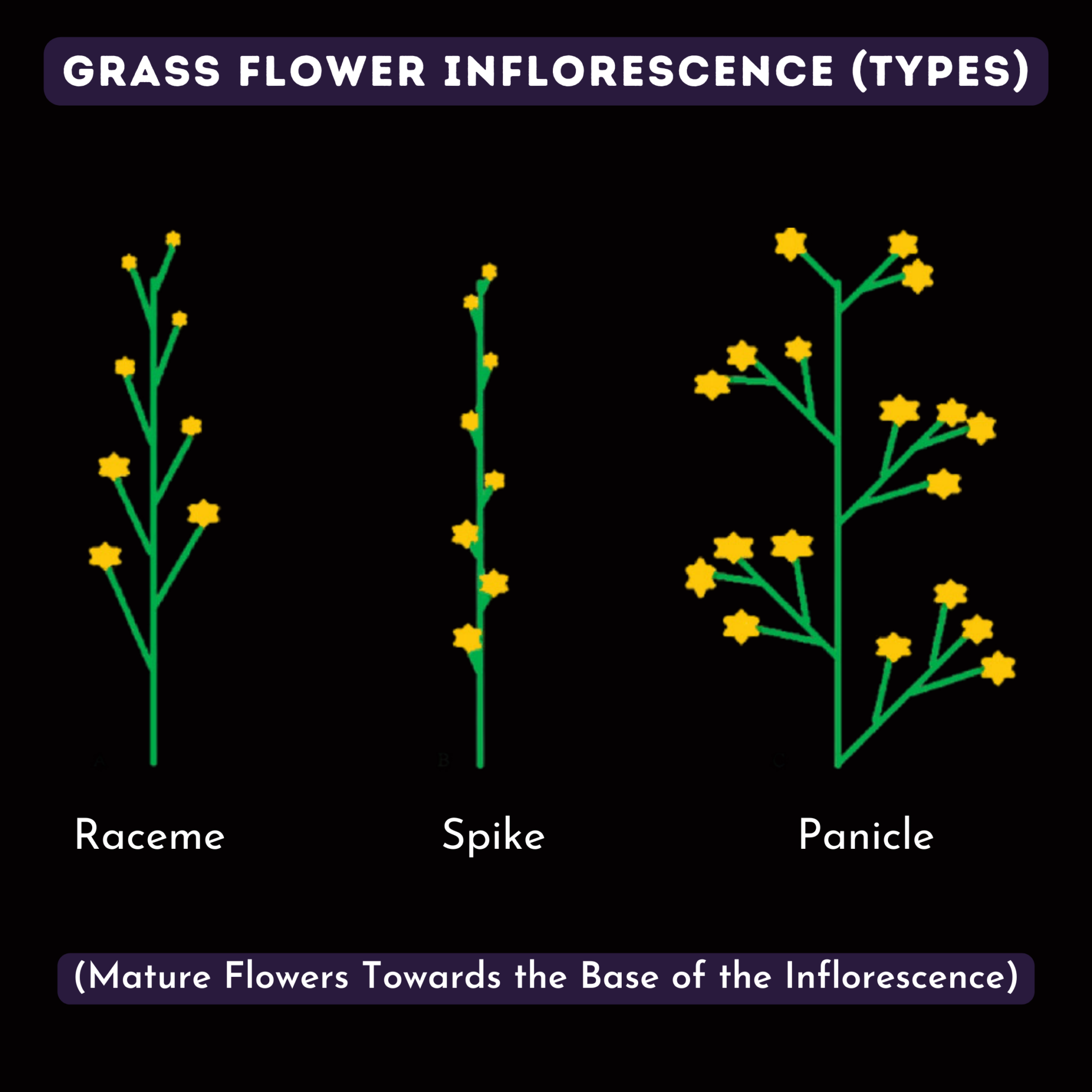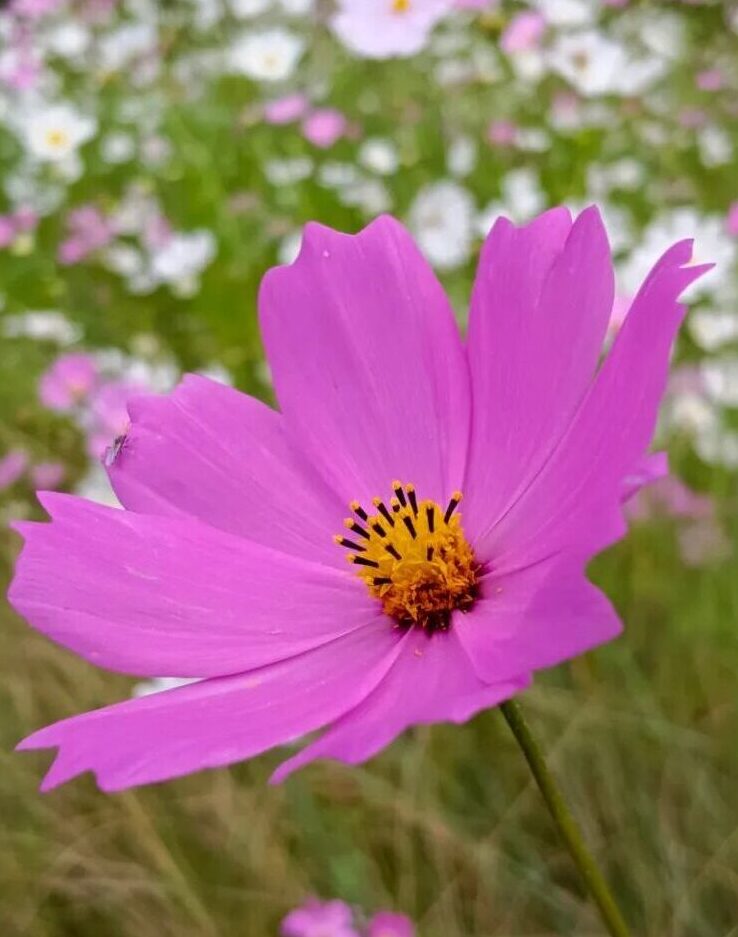If Grass Flower is growing in your garden, and you do not know what to do, try to identify it first.
You may have heard of Grass Flower walls or beds, but they are neither attractive nor beneficial to you and your lawn.
Therefore, keep reading till the end to understand the anatomy of grass flowers and what to do with them next.
Table of Contents Show
How to Identify A Grass Flower?
Unlike other plants with showy flowers, Grass Flowers are made of multiple spikelets in the form of inflorescences.
To understand spikelets, take the example of wheat. So, the inflorescence is a cluster of spikelets at the top of the wheat plant.

Most Grass Flowers are white but can be purple, red, yellow, or even orange.
Due to these colors, Grass Flowers are equipped for crafting garden backdrops, wall decor, artificial walls, bed borders or edging, etc.
You can identify the Grass Flowers with the help of color and their inflorescence.
Grass Flower [Structure & Anatomy]
Generally, there are 3 major grass flower inflorescence types: spikes, racemes, and panicles.
These all have distinct inflorescence structures with different variations.
1. Spikes
In this type of inflorescence, the spikelets are directly attached to the central axis of the inflorescence.
Here, a stem that is the central axis of the inflorescence is usually known as a rachis, which may or may not have branches.
Some grass varieties with spike inflorescence as their floret or flower are Ryegrass, Rice, Cattail Timothy, and Paspalum species.
2. Racemes
The spikelets in the raceme-type inflorescence are present at individual pedicel.
Meanwhile, a pedicel is a small stalk branching out from the main rachis stem with individual spikelets.
In raceme inflorescence, the length of the base pedicel with older spikelets is much longer than other upper younger pedicels.
Raceme inflorescence-type plants include Rattleweed, Snapdragon, and Mustard.

3. Panicles
Also known as compound raceme, panicle-type floret has lateral branches that bear flowers and raceme inflorescences.
A panicle inflorescence is a compound raceme due to lateral branches shooting from individual pedicels of raceme floret.
Meanwhile, panicles have branches of varying sizes and shapes shooting from their rachis.
For example, Indiangrass, River Oats, Johnsongrass, and Switchgrass have panicle-type inflorescence.
Why Does Grass Produce Flowers?
Like any other plants, grass plants undergo and start producing flowers when reproduction time arrives.
Even though grass flower is simple with no distinct attractive features, grass blooms yearly.
However, the likelihood of lawn grass producing flowers is low if you mow the lawn often.

Meanwhile, the time and duration of the grass flower blossoming vary depending on the variety of grass.
Similarly, depending upon the care factors in which grass grows, they take about 3 months to years to mature and start flowering.
More importantly, flowering leads to the seed formation stage upon successful pollination by winds.
Without external interference, seeds would begin to form and eventually reseed themselves.
However, water your lawn by 1 inch weekly in winter and 2-3 times in summer.
Should You Let Grass Flower?
Letting grass multiply by self-seeding will help you with a denser lawn but has other consequences.
So, grasses focus all of their energy on producing seeds. While doing so, the grass plant forgets to repair itself or keeps its growth on hold.
It causes grasses to become weak, but giving your plant fertilizer might help them somewhat. However, try discouraging flowering and seed formation altogether.
That said, do not cut the grass too short to prevent flowers, as cutting grass too short causes stress.
Frequently mow your lawn by cutting one-third of the grass’s stem to keep them healthy and discourage flowering.
Moreover, you can use Citrus oil or vinegar to prevent undesired grasses in your lawn.
Alternatively, Total Vegetation Control and Turf Builder are best for killing such grasses.
Besides, some ornamental grasses with purple flowers, such as Mondo Grass, Monkey Grass, and Pampas Grass, are fantastic for grass-raised beds, lawn flower bed dividers, and bed edging.
Grass Flower Vs. Cosmos Flower
The astonishing Cosmos belonging to the family Asteraceae are perennial or annual plants growing to 1-7 feet.
Whereas most grasses are perennials with heights ranging from 0.5 inches to 8 feet. Moreover, grasses belong to the family Poaceae.
Cosmos produces a large, showy flower head with individual flowers. However, the inflorescence of Grass Flowers in racemes, spikes, or panicles.

Grass Flowers are usually green but have other color variations too. For example, white, purple, or yellow.
In contrast, Cosmos Flowers appear in shades of pink, white, or orange.
Cosmos plants carry simple foliage arranged oppositely in the stem, whereas grasses bear long, narrow, and blady leaves with parallel veins.
FAQs About Grass Flower & Grasses
Is Grass a wild plant?
The term ‘grass’ comprises both cultivated and wild monocot plant varieties.
In fact, members of the grass family Poaceae have distinct long narrow leaf blades and parallel venation on the foliage.
Is Bermuda grass the same as Carpet grass?
Bermuda grass, also called Scutch grass, has 2-6 perfectly digitated racemes.
However, the inflorescence in Carpet grass consists of 2-5 alternately digitated or sub-digitated racemes.
From Editorial Team
Conclusion!
Although the grass flower is simple with no special features, they still have distinct floret structures to distinguish themselves.
Frequently mowing lawns can discourage grass flowering and eventually prevent seed formation.
Also, feed the grasses nitrogen fertilizers during flowering, as they become weak and prone to fungal invasion.


